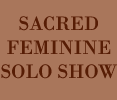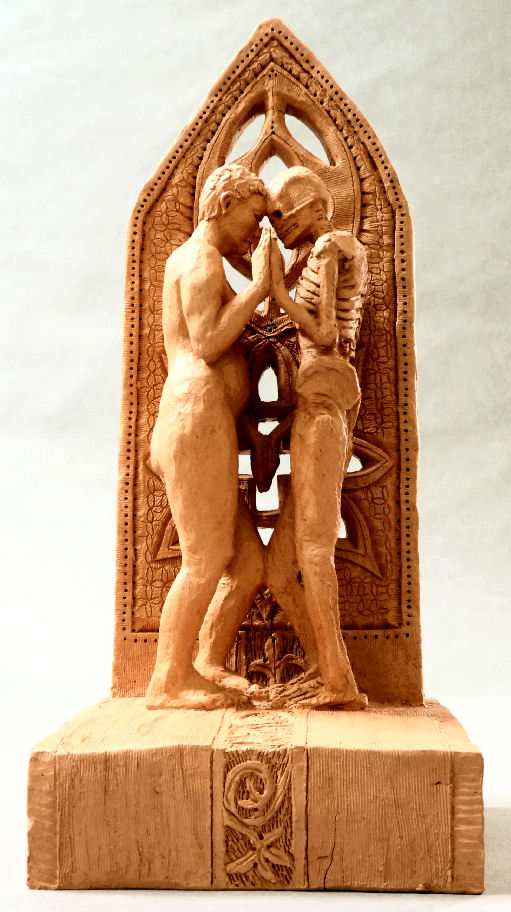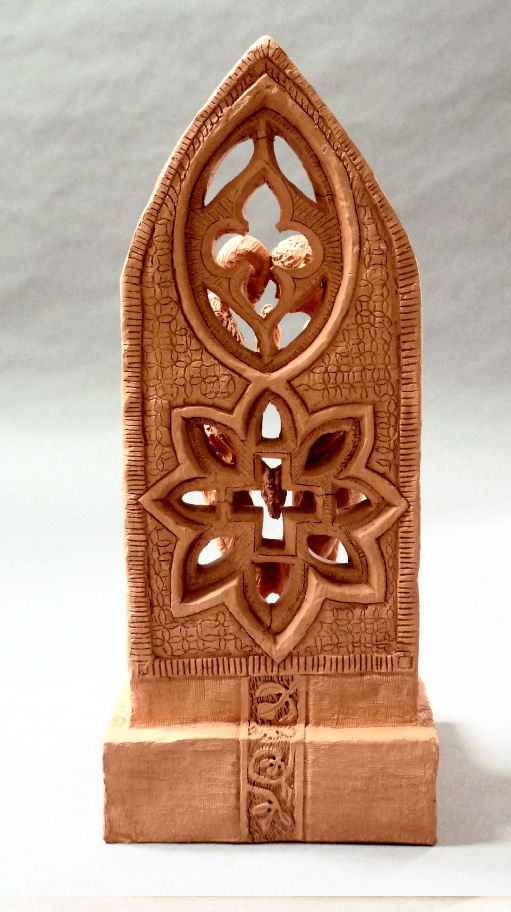
|
|
|
This sculpture highlights the
relationship between life and death when they are touched by the
divine. The window illustrates the metaphor that death and life can
face each other, when they are infused by the light of the divine,
represented by the window. Without the divine these two elements are
at odds with each other. However, the divine offers a safe haven and
a still point of mediation between these two opposites.
In a weary contrapposto, I rest up against a mirror. Yet, my own reflection does not shine back; instead a skeleton mirrors my form. I stand with my arms in the Segan Semui-in mudra. My right hand is in the Abhaya mudra: the Fear-Not mudra which shows good intentions, a sign of peace and a way of showing that I mean no harm because I don’t carry a weapon in my hand. My left hand forms the Varada mudra: the Welcome or Wish-Granting mudra which signifies compassion. Combined together, the Abhaya and Varada mudras structure the Segan Semui-in mudra. Practically and metaphorically, neither of these figures can stand up by themselves, yet by leaning against each other they gain support. They are bound together like the yin yang. Life and death, as opposite as day and night, come together to complete the grandest cycle of all. Like the yin yang, life carries a piece of death in her; conversely, death carries a spark of life in her withered form. The church window they rest against also offers support. I am not at peace with death; I have not accepted death into my home; I desperately want to be among the living. Yet, my near-death brush with breast cancer metastasized to my liver forced me to go toe-to-toe with death, and at the height of my illness I was staring down the barrel of a loaded gun. In some of my sculptures I run from death, in others death wears a halo and is part of the universe’s pantheon and cycle of life. In this sculpture I face death head on, not because I want to, or from some heroic stance, but because I have not been given a choice; I have been cornered like a wounded animal by death. I am powerless to death. It is the final big chill, the equalizer. Like a tsunami it doesn’t care about the destruction it leaves in its wake. Death is not about life. Death is about death. Although I cannot, I still strive, for my own sanity, to meet death on my terms. Because it has cornered me, I will try and face it with every weary shred of dignity I can muster. If I look it in the eye, can I make peace with it? No, I doubt it, not at this stage of my life. But it is better for my own sanity to stand and face it in the eye. I have stopped running from death and there is a bit of freedom in that. My son and I went to several churches in our Pittsburgh area to study the architecture; I took my camera and recorded several windows that I incorporated into my window. The designs I used include the equal armed, or Greek cross with its masculine right angles and geometric structure. The Greek cross is mentioned by Dan Brown in The Da Vinci Code: “The head of this key was not the traditional long-stemmed Christian cross but rather was a square cross—with four arms of equal length—which predated Christianity by fifteen hundred years. This kind of cross carried none of the Christian connotations of crucifixion associated with the longer-stemmed Latin Cross, originated by Romans as a torture device. Langdon was always surprised how few Christians who gazed upon “the crucifix” realized their symbol’s violent history was reflected in its very name: “cross” and “crucifix” came from the Latin verb cruciare—to torture.…equal-armed crosses like this one are considered peaceful crosses. Their square configurations make them impractical for use in crucifixion, and their balanced vertical and horizontal elements convey a natural union of male and female…” (p. 145). One of my goals as an artist is to image harmony between the masculine and feminine; to this end the Greek cross is an ideal symbol with its promise of peace. Balancing the masculine lines of the equal armed cross is a flower composed of yonic forms with feminine curved lines. Yoni is Sanskrit for vulva, source, origin, vagina. Barbara G. Walker writes about the yoni in her Woman’s Dictionary of Symbols and Sacred Objects that “the shape of external female genitalia , which the ancients clearly recognized as the seat of female sexual power…the sign of the yoni passed into Western symbolism under such titles as mandorla (almond) and vesica piscis (vessel of the fish). Mandorla means ‘almond’. Almonds were female-genital symbols and maternity charms from very ancient times.”(p.18) The floral pattern edging throughout the piece harkens to growth and living things and holds out hope for my own flourishing life. This piece, and the five preceding it, deal with breast cancer metastasized to my liver. There are over two dozen skeletons in these pieces that reference death. I am hoping this piece will be the end of this series on death. It is has brought up emotions to sculpt death in such frank terms and to have made six sculptures in succession that deal with the tension between living and dying. A friend visiting my studio commented on how brave and courageous I was to sculpt these things; years ago I would have only heard empty praise. Now, her comment rings true, it did take courage to sculpt this. Yet, the other option would have been even harder, that of running away from and denying the presence of death. I don’t want to wallow in negativity, and I hope that sculpting these dark recesses will contrast with future work that will illuminate the joy in my live, bringing it into focus in much the same way the dark makes the light even brighter. I want to manifest life and wholeness. I can sculpt wholeness, and other times I will sculpt pain with the intent to exorcize it out of my body and out of my life.
For questions or comments about Cydra's art, please email: womansculpture@icloud.com |




